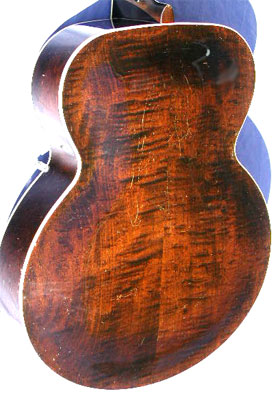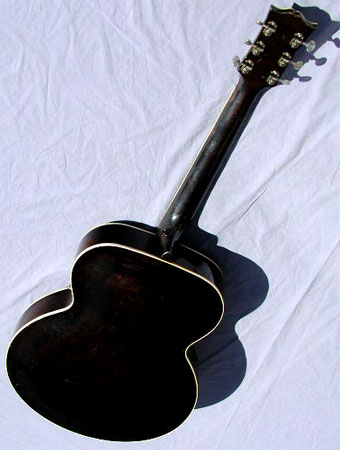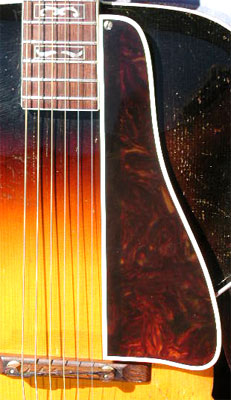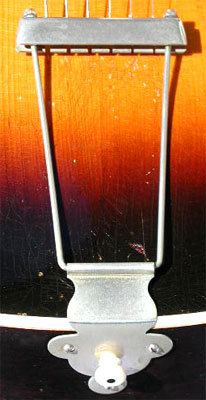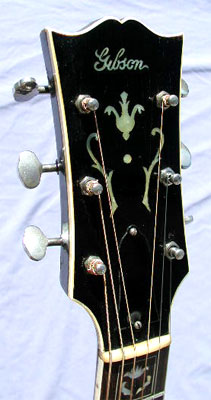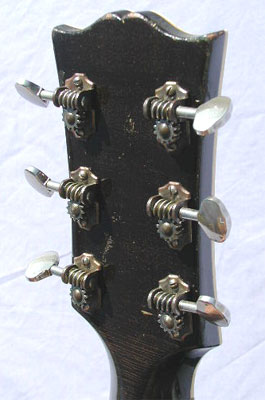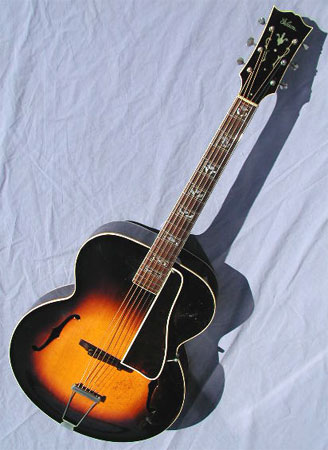
Home / Instruments /Accessories / Ordering / Tips
archtop.com
1936 Gibson L-7
Status: Pricing and hold status for all instruments currently available is shown on our Instruments page here. If this instrument does not appear on the Instruments page it has been sold, and is no longer available. Photos and descriptions of Previously Sold instruments may be found here. To be notified of examples of this model or similar instruments in the future, please contact [email protected],. Please be specific on which instrument(s) you're looking for, and we'll be happy to contact you as soon as they become available.
Serial #: 92813
Body size at lower bout: 17", Scale length: 25 1/2" Nut Width: 1 11/16"
Finish: Dark tobacco sunburst finish, nitrocellulose lacquer type.
Materials: Solid handcarved maple back, sides and neck; handcarved bookmatched solid spruce top; Brazilian rosewood fingerboard and compensated bridge, ornate mother of pearl "picture frame" fingerboard inlays; older fat script Gibson peghead logo with "vase and curlicue" inlay; triple-bound body, bound fingerboard and headstock.
Hardware: All original hardware includes original nickel-plated trapeze tailpiece; original Brazilian rosewood compensated bridge; original bound tortoise pickguard; original nickel Grover Sta-Tite tuners; adjustable truss rod.
Notes: Regular visitors know that we have a special place in our hearts for the X-braced Gibson archtops of the '30's. In 1934, to meet the increased demands for volume required by the Big Band era, Gibson increased the body size of its professional guitars from 16" to 17" in the lower bout. Just as significantly, Gibson introduced the X-brace support system for the first time in an archtop guitar. The X-brace had been used by Martin in their peerless flat tops, and has been resurrected by modern archtop builders like Benedetto and others for it's warm woody tone with greater sustain and increased bass response.
The L-7 was Gibson's most popular 17" guitar, with the same size, scale and materials as the L-5. Interestingly, the L-7 of this era had a much more ornate inlay pattern than it's spendier cousin. This example has been very well cared for, and has 100% of its original hardware intact. Made in late '35 or early '36, the guitar shows the 20's style trapeze tailpiece, shallower arch, and smaller f-holes of the very earliest 17" "advanced model" bodies.
The guitar retains all its original sunburst finish and original hardshell case. The body is in excellent condition, and shows nice flame figure under the deep walnut finish. The instrument is without cracks or repairs, and only typical light scattered lacquer dings on top and back. The neck profile is very comfortable, with almost no thumbwear, and is distinctly slimmer than the full necks found on later examples, and has the narrow heel of the late 20's Gibsons. The voice is open, even and warmly resonant, great for chord melody, vocal backup, fingerstyle play or recording. A pioneering example from Gibson's Golden Era of acoustic guitars.
Setup: The frets have been precision leveled, recrowned and polished; trussrod tension and neck relief adjusted; bridge height adjusted; bridge compensation set; string slots at nut and bridge inspected and recut as necessary; bridge foot contour inspected and fit to top as necessary; bridge radius inspected and recurved as necessary; bridge wheels and tuners lubricated; fingerboard and bridge oiled; body and neck cleaned and hand polished.
This instrument is strung with medium gauge bronze strings (.013-.057). The guitar will accommodate lighter or heavier gauge strings, according to preference. String action is set at 5/64" to 6/64" at the 12th fret, with moderate relief for acoustic playing with medium strings. The action may be lowered or raised to your requirements with the adjustable bridge.
Case: Original deluxe black Gibson hardshell case.